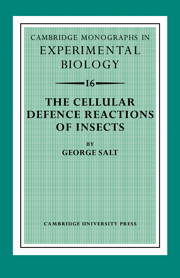Book contents
- Frontmatter
- Contents
- Acknowledgements
- 1 INTRODUCTION
- 2 PHAGOCYTOSIS
- 3 ENCAPSULATION
- 4 NODULE FORMATION
- 5 OBJECTS THAT EXCITE CELLULAR REACTIONS
- 6 THE REACTIONS OF INSECT BLOOD CELLS
- 7 CELLULAR REACTIONS AND IMMUNITY
- 8 A COMPARISON OF INSECT AND VERTEBRATE DEFENCE REACTIONS
- References
- Index of organisms
- Index of subjects
- Plate section
5 - OBJECTS THAT EXCITE CELLULAR REACTIONS
Published online by Cambridge University Press: 20 April 2010
- Frontmatter
- Contents
- Acknowledgements
- 1 INTRODUCTION
- 2 PHAGOCYTOSIS
- 3 ENCAPSULATION
- 4 NODULE FORMATION
- 5 OBJECTS THAT EXCITE CELLULAR REACTIONS
- 6 THE REACTIONS OF INSECT BLOOD CELLS
- 7 CELLULAR REACTIONS AND IMMUNITY
- 8 A COMPARISON OF INSECT AND VERTEBRATE DEFENCE REACTIONS
- References
- Index of organisms
- Index of subjects
- Plate section
Summary
The cellular reactions of insects have been described above as mechanisms of defence against infection. They invite further consideration as an aspect of cell biology. In particular, an attempt to understand cellular defence reactions must include attention to the stimuli that excite the cells. A first step in the investigation of those stimuli is to survey the various kinds of objects to which reactions are made.
OBJECTS PHAGOCYTOSED
Practically all micro-organisms that enter the haemocoele of an insect are phagocytosed. For analytical purposes, therefore, interest centres on those species to which the phagocytes are said not to react. Some reports of the absence of reaction are beside the mark, because the organisms to which they refer had not been in actual contact with the blood, and therefore could not have stimulated the cells (Salt, 1969). Very few micro-organisms, if any, can be accepted as being able to challenge phagocytosis with impunity (p. 20), and nothing is known about the means by which they do so. Whether they actively inhibit phagocytosis, or whether they passively avoid stimulating the blood cells, seems never to have been investigated.
Inert particles of many kinds have been injected into insects and found to be phagocytosed. Examples are listed in table 5. In considering them, it will be wise to bear in mind Rowley's caution (1962) that it is probably fallacious to regard any particle in serum as actually inert.
- Type
- Chapter
- Information
- The Cellular Defence Reactions of Insects , pp. 56 - 67Publisher: Cambridge University PressPrint publication year: 1970

